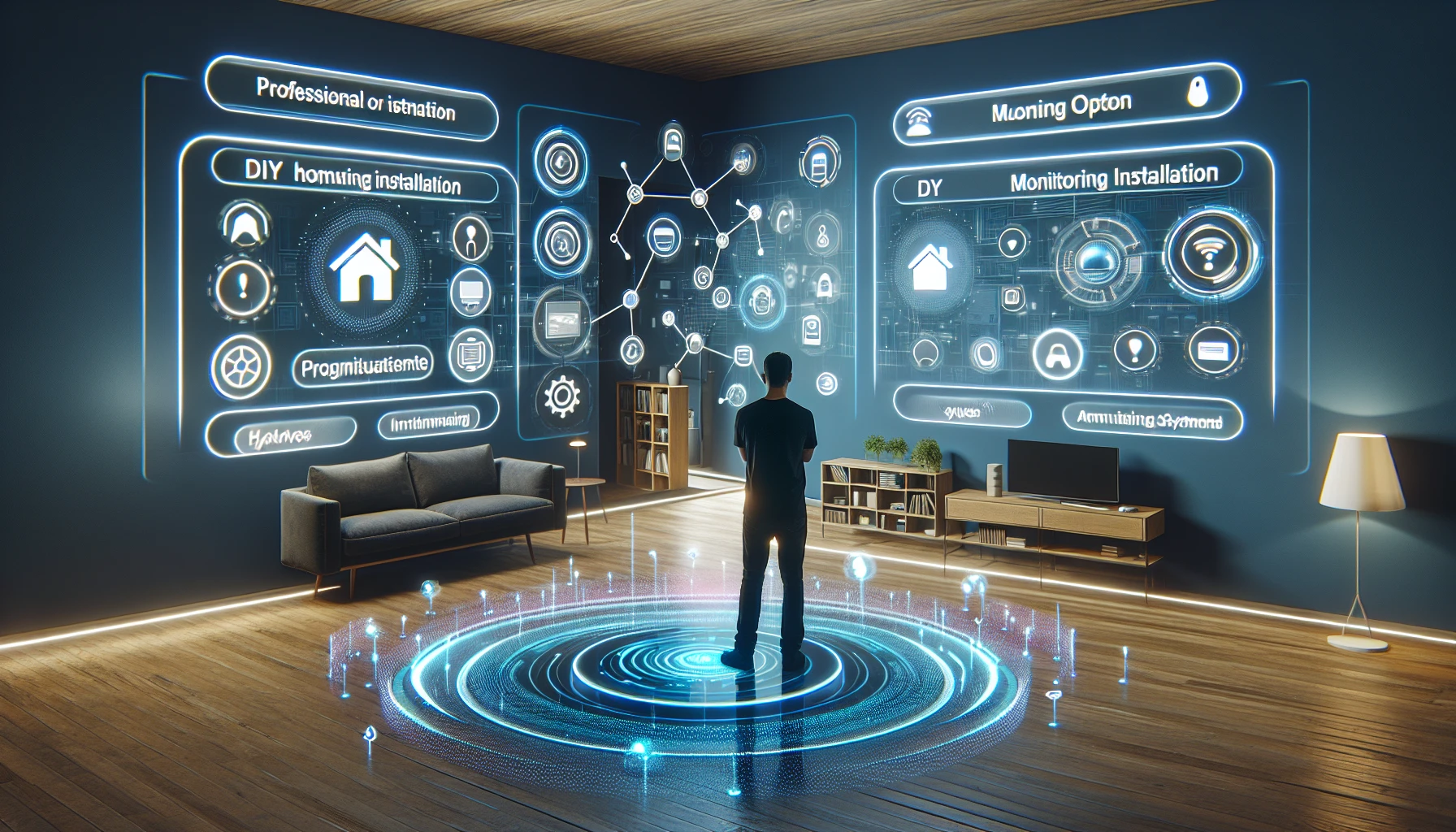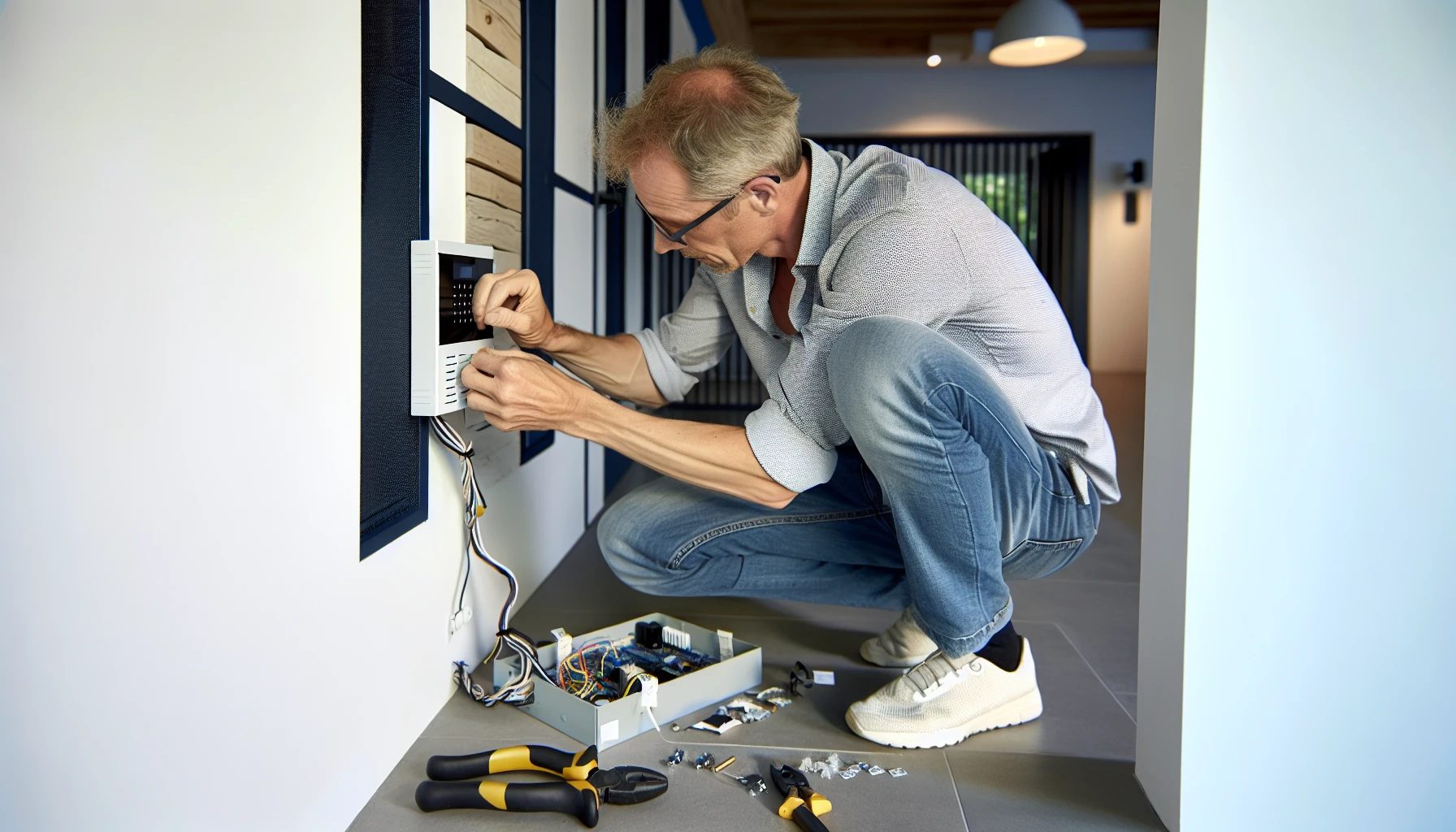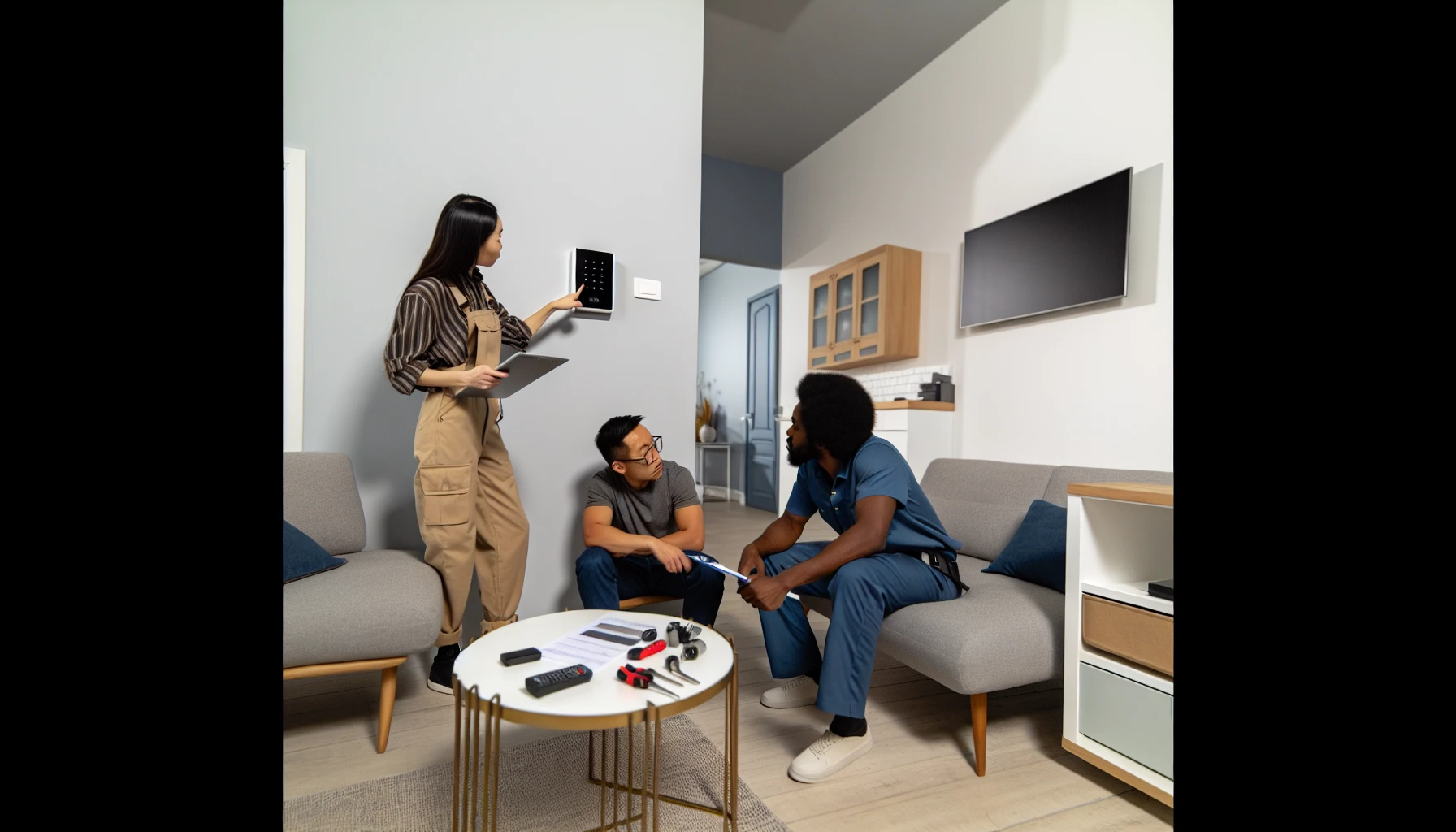Securing your home is more important than ever, and with the rise of DIY home security systems, it’s never been more accessible or affordable to install a security system. This comprehensive guide will walk you through choosing, installing, and maintaining a home security system that suits your needs and budget. With our step-by-step instructions, you’ll be able to protect your home and loved ones with ease.
Key Points
- Choose a home security system based on installation, monitoring options, and smart home integration.
- Ensure you have the essential tools for DIY installation, including a control panel, sensors, and detectors.
- Follow step-by-step instructions to install your security system. Consider cost considerations and additional features like environmental sensors when enhancing your system.
Choosing Your Home Security System

Before you start your DIY security project, selecting a suitable home security system to meet your needs is a good step. When deciding, consider factors such as professional vs. DIY installation, monitoring options, and smart home integration capabilities. While professionally installed systems often involve significant installation fees and permanent modifications to structures, DIY systems are wireless and can be installed by homeowners, offering flexibility and cost savings.
Resources like Top Ten Reviews, SafeWise, MyMove, Vector Security, and CNET can guide you through the wide range of home security systems, offering helpful information about the top options. A complete home security system offers numerous advantages, including deterring potential intruders, providing an alert if someone gains entry, enabling emergency services to be contacted in an emergency, and potentially reducing home insurance premiums. However, the downsides may include installation costs, privacy considerations, and scheduling issues.
Essential Tools and Components for Installation

After deciding on your preferred home security system, the next step is to assemble the necessary tools and components for installation. A DIY home security system typically requires a control panel, sensors, and detectors. Additionally, you’ll need tools such as screwdrivers (Philips head and flathead), strippers, crimpers, drill/driver (cordless), drill bit set, hammer, pry bar, and wire stripper/cutter. Installing diy home security systems can be a manageable task for homeowners with the right tools and components.
The primary control panel and keypad are the core components of a home security system, allowing comprehensive access and control of the alarm system. The control panel performs the following functions:
- Receives signals from various sensors and devices, such as door/window sensors, motion detectors, and cameras
- Processes these signals and initiates corresponding actions, such as sounding an alarm, sending alerts to the monitoring station, or activating connected devices like lights or locks
- Displays information regarding the system status
- Enables users to arm or disarm the system
Some systems are compatible with Alexa Google Assistant, allowing voice control.
Motion detectors are critical components of a home security system, as they detect activity within a specific area and set off an alarm if needed. With the right tools and components, you’re ready to start the installation process.
Step-by-Step Installation Process

Installing a home security system can appear challenging, but our comprehensive guide equips you with the knowledge to handle the task. We’ll cover mounting the control panel, setting up sensors and detectors, and connecting to monitoring services.
Mounting the Control Panel
First, you’ll need to mount the control panel on a suitable wall. This can vary depending on the security system manufacturer’s recommendations, but some options include walls with removable double-sided adhesive and walls with screws or fasteners. To mount the control panel, you’ll need a 4-in-1 screwdriver, drill bit set, cordless drill/driver, hammer, pry bar, and wire stripper/cutter.
The recommended height for mounting a home security control panel is no more than 48 inches to the topmost operable button. If ADA regulations do not apply, it is advisable to center it at 54 inches. Ensure the control panel is near an entry point and power source for easy access and functionality.
Setting Up Sensors and Detectors
After mounting the control panel, it’s time to set up the sensors and detectors. Here are the steps to follow:
- Install door and window alarm sensors. These are typically included in a home security system.
- Consider adding motion detectors to your system. These can provide an extra layer of security.
- The recommended number of entry sensors depends on the number of windows and doors in your home. It is also subject to personal preference.
Strategically place smoke detectors on every home floor, bedroom, hallway, or stairway for optimal safety. To determine the best placement for sensors, refer to the instructions included with your home security system or consult a guide for efficient motion sensor placement. Most sensors feature a peel-and-stick backing, enabling secure placement and easy repositioning.
Connecting to Monitoring Services
With your sensors and detectors in place, the next step is connecting your security system to monitoring services. You can choose between professional monitoring services, which provide 24/7 surveillance and dispatch emergency services if needed, or self-monitoring options, such as Abode, Kangaroo, SimpliSafe, Ring Alarm, and the Wyze home monitoring system.
For example, if you have a Ring Alarm Pro system, you can enroll in the Ring Protect Pro subscription plan for $20/month per location. This plan offers 24/7 professional monitoring, backup internet, and emergency dispatch. To enroll, navigate to Menu > Settings > Type > Professional in the Ring app, remembering that a compatible Ring Protect subscription is required.
Integrating Smart Home Automation

Now that your security system is running consider enhancing its capabilities with smart home automation. Integrating smart home automation with your security system offers increased convenience and functionality, such as managing your system remotely, receiving notifications when something is activated, and automating tasks like starting lights when motion is detected.
Smart home automation integrations can include voice control, remote access, automation, and integration with other smart home devices. Abode, for example, provides the most comprehensive smart-home integration, including compatibility with Amazon Alexa, Apple HomeKit, Google Assistant, IFTTT, Z-Wave, and Zigbee. Systems like SimpliSafe are compatible with two leading voice assistants – Amazon Alexa and Google Assistant. This enables users to arm and monitor the system using simple voice commands conveniently.
When selecting security cameras for your system, opt for models produced by companies that offer robust security and privacy safeguards. By integrating smart home automation, you can maximize the potential of your home security system and enjoy added convenience and peace of mind.
Testing and Troubleshooting Your Security System

Consistent testing and problem-solving are vital measures that help sustain the efficiency of your home security system. Follow the directions outlined in the security system owner’s manual to ensure all components function correctly. Common issues associated with home security systems include compatibility issues, false alarms, blind spots, damaged equipment, and incorrect programming. To troubleshoot these issues, check for compatibility, ensure proper installation and maintenance, review camera placement, inspect and replace damaged equipment, and update programming.
Resources are available for testing and maintaining smoke detectors in a home security system. A Ring representative advises customers to test sensors regularly, particularly as they approach the four-year mark since this is when they may begin to reach the end of their lifespan.
Security System Cost Considerations
When choosing a home security system, considering the associated cost is essential. Installation fees, equipment costs, and monitoring services impact the price of a security system. A professionally installed home security system can range from $49 and above, while a sound starter home security system costs approximately $200. Consider these costs, including home security systems, when choosing the best option for your needs and budget.
Enhancing Your System with Additional Features
To further improve the effectiveness of your security system, consider incorporating additional features such as:
- Environmental sensors: These can safeguard your equipment and enhance power usage efficiency, helping prevent destruction from fire, water, and gases.
- Cameras: Adding cameras to your security system can provide visual surveillance and help deter potential intruders.
- Glass-break detectors protect against break-ins through glass surfaces by detecting the sound frequency and vibration patterns produced when glass is broken and triggering an alarm when a break is detected.
By incorporating these additional features, you can enhance the overall security of your system and better protect your home or business.
When selecting security cameras, choose models from companies that offer robust security and privacy safeguards. Also, consider the benefits of incorporating environmental sensors and glass-break detectors into your home security system to provide even greater peace of mind.
Maintenance and Upkeep of Your Security System
Keeping your security system in prime condition is vital to guaranteeing its effectiveness over an extended period. Key maintenance responsibilities include:
- Conducting regular inspections of all physical security components
- Testing and inspecting fire alarm and intrusion alarm systems
- Maintaining and cleaning sensors and cameras
- Replacing batteries
- Scheduling regular maintenance checks
- Requesting an annual inspection by professional technicians
It’s advised to replace the batteries in your home security system every 3-5 years. Keep an eye out for potential issues that may be encountered when using a home security system, such as:
- Compatibility issues
- Costly hardware
- Blind spots
- Low sound
- False alarms
Address them as needed.
It’s generally recommended to update a home security system every 5-10 years, but routine inspections for potential malfunctions or problems should be conducted regardless of the system’s age.
Summary
In conclusion, DIY home security system installation is a straightforward and cost-effective way to protect your home and loved ones. By carefully choosing the right system, following our step-by-step installation guide, and integrating smart home automation and additional features, you can create a comprehensive security solution tailored to your needs. Regular testing, troubleshooting, and maintenance will ensure your security system remains in optimal condition, providing peace of mind for years.
Frequently Asked Questions
Installing a security system yourself is possible with the proper guidance and support from the company providing the kit. Many alarm systems are straightforward to install, with instructions, videos, and live chat/phone support.
ADT does provide a free security system valued at around $850. However, an additional Customer Installation Charge is required before installing the system.
Installing a home security system can increase the value of your property and deter crime, making it an extremely worthwhile investment. A security system also leaves your family and property safe and protected.
For optimal protection against burglary, it is best to have both a security system and cameras installed. Alarm systems will alert you when a break-in occurs, while cameras can provide video footage of the crime.
On average, a home security system will cost around $700, ranging from $280 to $1,150, depending on the equipment and features. The installation costs will vary based on whether you choose wired or wireless systems.




